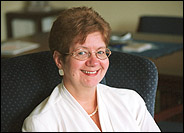kaleidoscope
Diane Telmosse: dedicated to a "T"
 PHOTO: Owen Egan
PHOTO: Owen Egan |
|
When Diane Telmosse picked up the phone 29 years ago and dialled the number listed in an ad looking for a francophone secretary, she had no idea what she was getting herself into.
"I didn't even know it was McGill," she laughs, seated in one of the blue velvet chairs in the office of her current boss, Laurie Gottlieb, director of the School of Nursing.
Telmosse was then a 20-year-old recent graduate of the now-gone Chatelaine Business College. She had no English and was pretty ambivalent about working in the big city. A native of Ste-Hyacinthe, where her two sisters still live, Telmosse would have returned to her hometown had she been able to find work there.
But such was not her fate. As she recounted last April in her acceptance speech for the Anne McCormick Award for Excellence in the Faculty of Medicine, "I remember walking up the hill on University saying to myself: 'My God!' I could not believe my eyes -- such tall buildings and so many people. It was only after the interview that I learned that the job was at McGill University. And so began my experience with McGill."
Two years ago, her position at the Montreal General Hospital's Division of Clinical Epidemiology was cut. The memory of the loss of that job still stings and it remains hard for her to talk about.
"They shouldn't do that to people," she says adamantly. "Especially to someone like me who hates change." She laughs.
Despite that experience, Telmosse has adapted remarkably well to her new milieu at the School of Nursing and receiving the Anne McCormick award, named after the woman who served as assistant to the dean of medicine for more than 20 years, is a mark of her outstanding contribution.
In fact, Telmosse admits to being very happy in her new position. Though nervous, initially, about the move to an all-female milieu and adapting to a new boss, she has found that "the chemistry is there."
"With Dr. Gottlieb, I liked her right from the start," says Telmosse, explaining that to be someone's personal secretary you have to get to the point where you can read the person's mind. With Renaldo Battista [formally of Clinical Epidemiology at the MGH], it was like that."
Battista, a professor in the Department of Epidemiology and Biostatistics, is very glad that Telmosse has been recognized for her dedication. He recalls how once when they were working on an important grant proposal, 75 pages of crucial tables were gobbled up by a computer mishap. "She stayed that night and through the weekend to redo them," he recalls. In fact, she was there until 4 am on the Monday morning of the deadline date, fills in Telmosse.
Adapting to new technologies has been nerve-wracking at times, Telmosse acknowledges. "I was taught on a manual typewriter. We were all afraid of the [IBM electric typewriter] Selectric," -- never mind PCs.
Though at ease today with the computer and with numerous computer programs, Telmosse chooses not to have any form of secretarial technology at the home she shares with her 83-year-old mother, across the river in Ste-Catherine. "I have nothing at home. Otherwise, I would work at home and I prefer to work late here."
Telmosse considers McGill her second home. "McGill, c'est ma vie," as she puts it. She's here at 7:30 am,beating the traffic on the Champlain Bridge. "I have my coffee here, take my time to read my e-mails, then I get to work by 8 am."
Departure time depends on Gottlieb's needs. "I'm not an 8:30 to 4:30 person." While Gottlieb never asks Telmosse to work overtime, she appreciates her flexibility and ability to predict needs ahead of time. Describing her office as being like Berri de Montigny metro station in terms of the frantic activity that goes on, Gottlieb marvels at how Telmosse can "keep 10 balls up in the air," all the while maintaining a calm facade.
"If a TV reporter calls and I've got a class to teach, she'll have all my materials ready for me. She makes sure things are done on time and she keeps me on track."
Even to the extent of saving Gottlieb from doing things she might later regret. "Sometimes, I'll write a letter and she'll hold it for a day. Then she'll ask me: 'Do you really want to send this?'"
Telmosse, for her part, is happy so long as she's happy with the people around her. "For me, it's the people; it has to work well with the people you work with."
 |
||||
|
I think it's because, in general, art is usually considered kind of pansy, and it has more to do with beauty and aesthetics, which men don't like. |
||||
Profscan imperilled
 ILLUSTRATION: Tzigane
ILLUSTRATION: Tzigane |
|
This week might mark the end of Profscan.com, the controversial web site created by a pair of Concordia students to assess the teaching abilities and styles of dozens of teachers at the university.
Profscan's originators, Ben Mattes and Bill Klein, have both graduated and don't have the time to keep Profscan running anymore. Unless they can find somebody who does, the popular site will be taken off the web this week. "There is no point in keeping it alive if it isn't going to be current," says Mattes.
He is frustrated with the Concordia Students Union, which has long expressed an interest in the site, but has offered little concrete support.
Mattes says Profscan was created to give students an open forum for expressing their feelings about teaching. "Teacher evaluations are done regularly, but once they're filled out, we never see them again. Two people get to look at them -- the teacher and the head of his department."
Concordia accounting professor Arshad Ahmad, a winner of a 3M teaching fellowship, one of Canada's top prizes for teaching, has mixed feelings about Profscan. "I think faculty should embrace any student attempt to give them feedback, whether it's good or bad." Ahmad says it's only natural for students to discuss their teachers' abilities, "if not on the web, then in the corridors."
But he worries that the students who evaluate teachers on Profscan might not be representative of all the students who took courses with the instructor. And he suspects that the questions posed by Profscan about teachers haven't been as carefully put together as the teaching evaluation questionnaires that have been designed by experts.
For his part, Mattes says students should take some of Profscan's evaluations with a grain of salt. "If there are only two people doing the rating, there is no way of knowing if it is representative. But if there are 15 or 20 students writing in and the evaluations converge on common points, I think you can assume it's fairly accurate."
 |
||||
|
In 2020, I would see a third of a CEO's time being spent on issues bigger than the company -- world education, world health, world peace, the environment. |
||||
Not for the Science Hall of Fame
 |
|
Science has made many remarkable contributions over the past 20 years. And, according to the magazine Discover, science has also been connected to some dumb, devious and outright dangerous moments over the last two decades.
The magazine's current issue features an article entitled "Twenty of the Greatest Blunders in Science in the Last Twenty Years."
Discover's picks include the creation of killer bees. Bred to be hardy, these bugs became way too hardy -- not to mention occasionally murderous. Also listed were NASA's back-to-back multimillion-dollar miscalculations in sending space probes to Mars in 1998 and '99 that both went kaput shortly after reaching the red planet. The 1999 National Geographic discovery of the Èmissing link" between dinosaurs and birds, which turned out to be a Chinese farmer's prank, pmade the list.
The notorious Yale/Harvard study that declared that unmarried women at 40 were "more likely to be killed by a terrorist" than to find a husband was listed. A follow-up study by the U.S. Census Bureau indicated that, in fact, 24 percent of single women between 40 and 44 get married.
Another of Discover's "blunders" was NASA's 1996 announcement that a Martian meteorite contained flecks of chemical compounds (pictured) that suggested the existence of bacteria on Mars billions of years ago.
McGill astrobiologist Hojatollah Vali was part of the NASA team. The news caused a media sensation, but many scientists now dispute NASA's assessment. For his part, Vali has parried many of the criticisms and continues to study the meteorite. "We have to be careful; what we have so far are indications and indirect evidence, not proof," he told the Reporter last year.

